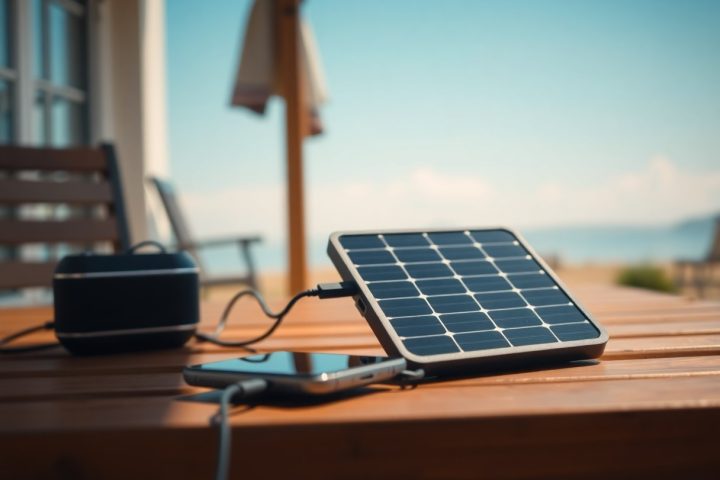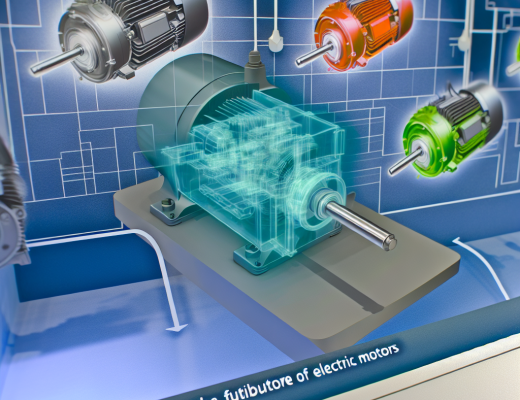Solar energy harnesses the power of sunlight to provide a sustainable charging solution for your small devices, such as smartphones and tablets. By using photovoltaic cells, a solar charger converts sunlight into electrical energy, allowing you to charge your gadgets even in remote locations. As you explore how these devices operate, you’ll gain insight into the technologies involved and the advantages of adopting solar chargers for your everyday needs. Understanding this process can help you make informed decisions about embracing renewable energy solutions in your life.
The Basics of Solar Energy
As you explore the world of renewable energy, solar energy stands out as a powerful and sustainable resource. It harnesses the sun’s rays to create electricity, offering an eco-friendly alternative to traditional energy sources. By using solar panels, you can convert sunlight into usable power, allowing you to charge your devices while reducing your carbon footprint. This technology not only benefits you but also contributes to a cleaner environment for generations to come.
How Solar Cells Convert Sunlight
The process of converting sunlight into electricity begins with solar cells, which are made of semiconductor materials. When sunlight strikes these cells, it energizes the electrons within, causing them to move and create an electric current. This flow of electricity is then harnessed and can be used to power small devices like phones or tablets, providing you with a sustainable charging solution.
Understanding Photovoltaic Technology
To fully grasp how solar chargers work, it’s important to understand photovoltaic (PV) technology. This innovative system captures sunlight and converts it into electrical energy through the use of solar cells, typically made from silicon. These cells are arranged in modules, allowing you to increase the amount of power generated based on your needs. When choosing a solar charger, knowing about PV technology will help you select the best options for your small devices.
Sunlight is the primary energy source for photovoltaic technology, which relies on the unique properties of semiconductor materials in solar cells to generate electricity. When photons from sunlight hit these materials, they liberate electrons, creating an electric current. This process is known as the photovoltaic effect. In your solar charger, this technology is harnessed in a compact design, making it ideal for powering small devices without relying on traditional electricity sources. By understanding how this technology operates, you can better appreciate the advantages it offers for portable energy solutions.
Components of a Solar Charger
It is important to understand the components that make up a solar charger for small devices. These chargers typically consist of three primary elements: solar panels, battery storage systems, and charging circuitry. Each component plays a significant role in transforming solar energy into usable power for your gadgets, ensuring convenient, eco-friendly charging options wherever you are.
Solar Panels
Between the various components, solar panels are the heart of the system, converting sunlight into electricity. They utilize photovoltaic cells to capture solar energy and generate direct current (DC) power, which is important for charging batteries or directly powering your small devices.
Battery Storage Systems
One important aspect of solar chargers is the battery storage system, which stores the energy produced by the solar panels. This allows you to use the power when needed, even in the absence of sunlight.
Systems for battery storage come in different types, such as lithium-ion or lead-acid batteries, each having its own advantages. Lithium-ion batteries, for instance, are lightweight and have a longer life cycle, making them suitable for portable solar chargers. On the other hand, lead-acid batteries are generally more affordable but less efficient. By selecting the right battery storage, you can ensure that your solar charger reliably powers your small devices whenever required.
How Solar Chargers Work
Some solar chargers utilize photovoltaic panels to convert sunlight into electricity, allowing you to charge your small devices on the go. These chargers are equipped with solar cells that absorb sunlight and convert it into direct current (DC) electricity, which is then stored in a battery or directly used to power your devices. This technology makes solar chargers a sustainable and eco-friendly solution for keeping your gadgets charged while minimizing your carbon footprint.
Energy Conversion Process
Beside the photovoltaic effect, which is the core of solar energy conversion, solar chargers integrate various components to maximize efficiency. The solar cells absorb sunlight and generate electrons, creating a flow of electricity. This electricity can either be used immediately to charge your devices or be stored in an internal battery for later use, providing you flexibility and convenience in outdoor or off-grid situations.
Charging Mechanism for Devices
About the charging mechanism, solar chargers are designed to deliver power to your devices seamlessly. They typically include USB ports or other connections that match the charging requirements of your electronics. The solar charger regulates the voltage output, ensuring that your devices receive the appropriate amount of power without risk of damage. This makes them compatible with a wide range of small devices, from smartphones and tablets to portable speakers.
Consequently, when you connect your device to a solar charger, the unit begins to draw energy from its internal battery or the solar panels, depending on the available sunlight. It converts DC electricity to match the voltage your device requires, providing a safe charging experience. This innovative charging mechanism allows you to charge your devices efficiently, whether you are on a camping trip or simply enjoying outdoor activities, ensuring that you stay connected and powered wherever you go.
Types of Solar Chargers
Unlike conventional chargers, solar chargers for small devices vary significantly based on their design and functionality. Here are the primary types:
- Portable Solar Chargers
- Solar Power Banks
- Solar Backpack Chargers
- Solar Phone Cases
- Multi-Device Solar Chargers
This diverse range caters to different needs, ensuring there’s a suitable option for everyone.
Portable Solar Chargers
Against the backdrop of an increasingly mobile world, portable solar chargers stand out for their versatility. These compact devices can easily fit in your backpack, making them ideal for outdoor adventures. They typically feature solar panels that capture sunlight and convert it into energy to charge your small gadgets on the go.
Solar Power Banks
Among the various solar charger types, solar power banks offer an efficient way to store energy. These power banks have built-in solar panels that allow you to recharge them in sunlight, and they store that energy for when you need to power your devices later.
Even when you don’t have direct sunlight, solar power banks can still charge your devices through conventional outlets. Most models come with multiple USB ports, allowing you to charge several devices simultaneously. This makes them particularly useful for trips or outdoor activities where electricity access is limited. With a solar power bank, you can enjoy the convenience of portable energy storage, ensuring your devices remain powered when you need them most.
Advantages of Using Solar Chargers
To harness the power of the sun, solar chargers provide a sustainable and convenient way to keep your small devices powered. They are portable, easy to use, and can charge various gadgets, making them an excellent choice for outdoor activities and emergencies. Additionally, solar chargers reduce your reliance on traditional energy sources, promoting a cleaner and greener lifestyle.
Environmental Benefits
Along with saving you money, using solar chargers significantly benefits the environment. By using renewable energy from the sun, you reduce your carbon footprint and dependence on fossil fuels. This shift contributes to cleaner air and a healthier planet, allowing you to make a positive impact through your charging choices.
Cost-Effectiveness Over Time
The initial investment in a solar charger may seem high, but it pays off in the long run. By utilizing free solar energy, you’ll reduce or eliminate your electricity costs for charging small devices. Over time, this leads to substantial savings, as traditional energy sources can be expensive.
This cost-effectiveness is amplified when you consider the longevity and durability of solar chargers. Many models come with warranty periods and are built to withstand outdoor conditions, meaning you won’t frequently need to replace them. As your usage grows, the savings continue to accumulate, making solar chargers a wise, long-term financial decision for your charging needs.
Limitations and Considerations
Many users may find that, while solar chargers offer great convenience, they also come with limitations that can affect their performance. For instance, factors such as weather conditions and the type of device being charged can influence how effective your solar charger will be. Being aware of these considerations can help you make informed decisions about when and how to use your solar charging solution.
Weather Dependency
With solar chargers, the weather plays a significant role in their effectiveness. On cloudy or rainy days, the amount of sunlight available for charging is greatly diminished, resulting in longer charging times or insufficient energy collection. If you live in an area with unpredictable weather patterns, you may need to plan ahead for optimal charging conditions.
Charging Efficiency
Against popular belief, solar chargers do not operate at maximum efficiency 100% of the time. The efficiency of your solar charger is influenced by several factors, including the angle of the sunlight, the quality of the solar panels, and the capacity of the internal battery. These elements can hinder the amount of energy the charger can convert into usable power for your devices.
Another important thing to consider is that many solar chargers have built-in batteries that store energy. These batteries typically have a limited capacity and may not always fully charge depending on the available sunlight. In practice, this means that charging larger devices or multiple smaller ones may take longer than expected, especially if sunlight exposure is limited. Ensuring your solar charger is strategically placed in direct sunlight can enhance its efficiency and lifespan, allowing for better energy conversion.
Summing up
Considering all points, a solar charger for small devices operates by converting sunlight into electrical energy, which is stored in an integrated battery. When you connect your device, the stored energy is transferred, allowing you to power or charge your gadgets sustainably. By incorporating photovoltaic cells, these chargers efficiently harness solar energy, making them an eco-friendly solution for your charging needs. Utilizing a solar charger not only reduces your carbon footprint but also provides a convenient power source on the go, ensuring your devices remain functional wherever you are.




